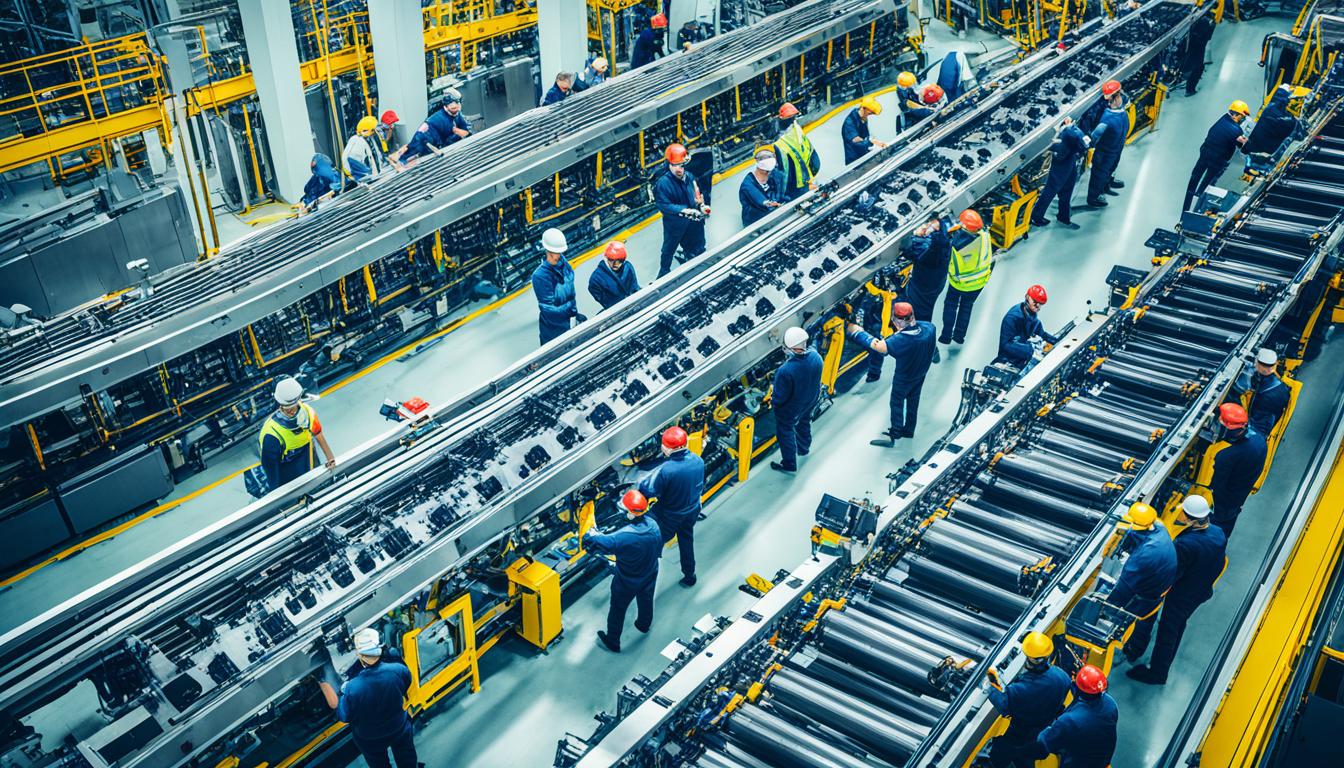Effective attendance management is key to better workplace productivity. It makes the most of human resources. By using attendance management software, companies can make things run smoother, cut down on mistakes, and ensure everyone gets paid right. This software boosts productivity by letting you monitor data in real time. It also makes sure the company follows labor laws.
Tracking employee attendance accurately helps a lot. It allows employees to manage their time better. It also helps managers and staff talk more effectively. This leads to smarter decisions for managing the workforce. Studies show that companies with automated systems cut down on time theft and absenteeism. This boosts productivity a lot.
Also, attendance management software makes things clearer and saves money. It keeps overtime and absence costs low. This helps companies control their budgets better. By looking at attendance patterns, companies can prevent employee burnout. This makes everyone happier at their job.
In short, a strong attendance management system means pay is right and follows the law. It creates a place where everyone talks clearly and works well together. Companies investing in these systems see big improvements. They find their work flows better and they do things more efficiently.
Introduction to Attendance Management
Attendance management is key for a company’s smooth operation. It helps keep track of who’s at work and who’s not. This keeps things running well and boosts employee work. Issues like being late or not coming can mess up work and cost extra money.

Systems like Juntrax allow easy sharing of attendance info. They work with other business systems for better management. With these, everyone can use the attendance system from anywhere. This was very handy during the COVID-19 crisis.
Using automatic systems for tracking attendance helps a lot. It makes fewer mistakes with pay, which makes employees happy. Companies also follow work laws better, avoiding fines. Plus, these systems give useful info to make departments work better.
Cloud-based systems are becoming a must-have. They’re great for staff working from different places. They can even use facial recognition for more security. This ensures the attendance data is accurate and safe.
HR teams can do their job better with these advanced systems. They help with making work flexible, which many employees like. A good attendance system is not just a tool. It’s a way to make the workplace fair and right.
Effective Use of Resources
Understanding how and when your staff can work is key. Managing their time well is very important for any company. It lets companies make the best use of their team for every project.
This means projects finish on time and everyone works efficiently. Keeping a good system for tracking work time can really help a business grow. It also keeps employees happy and saves money in the long run.

Understanding Staff Availability
It’s really important to know when your staff can work. This helps in planning projects better. With good management systems, you can put people where they’re needed most.
This good planning helps everyone do their best work. And when employees feel valued, they work harder and stay happier.
Optimizing Programs and Projects
To run projects well, you need good scheduling and management. Modern systems let businesses see how many people are working and where. This information is crucial for planning both now and in the future.
Using scheduling software makes everything run smoothly. It helps make sure that work is done well and on time.
Enhancing Manufacturing Efficiencies
In manufacturing, keeping the right number of workers is key. This helps keep productivity high. Almost 70 percent of car makers are now using smart factories. They understand the value of being efficient more than ever.
Manufacturing productivity measures how much you get out from what you put in. Things like labor and resources matter here. Using automation for keeping track of attendance boosts this. It cuts payroll mistakes by up to 80%. It also lets companies see how their workers are doing in real-time.
Good attendance systems can also cut down on people missing work. Big global companies saw a 40% drop in no-shows. These systems also make fewer mistakes in record-keeping. This makes work run smoother and workers happier. Tools like Tempus Central make people 30% more satisfied by letting them manage their info.

Taking care of machines is also important for keeping work going well. Using ERP software helps a lot too. It lets everyone communicate better, both inside and outside the company.
Last of all, planning work shifts well can make things run smoother. It reduces downtime and missed work. Doing this, along with using good attendance tools, keeps manufacturing efficient.
Cost Control and Reduction
Managing attendance well greatly helps businesses save money. Staff costs are often high, so it’s important to spend wisely. Using a time and attendance system prevents unnecessary overtime. This makes operations more efficient and keeps labor costs low.
An automated system reduces the need for manual shift planning. It gives detailed reports for better decisions in the future. It also manages overtime rules effectively. This saves a lot of money. For more information, see how time and attendance can help save businesses money.

Avoiding Unnecessary Overtime Costs
Controlling overtime is key to a cost-efficient operation. Costs from overtime add up due to staff shortages and bad planning. Attendance software stops these issues. It records hours worked accurately and alerts managers about overtime risks.
This prevents paying for too much overtime. To understand better, read about reducing overtime costs with software.
Reducing Absenteeism-related Costs
Absenteeism affects a company’s money. Tracking attendance helps manage it before it becomes a big problem. This lowers the need for temp workers and keeps productivity up.
Also, good software helps schedule staff well and predicts future needs. To learn about saving money with attendance systems, read this article.
Compliance and Regulatory Requirements
Following labor laws and rules is very important in managing work time well. The Fair Labor Standards Act (FLSA) says that workers get extra pay if they work more than 40 hours a week. The Affordable Care Act (ACA) also needs careful tracking of work hours to figure out who gets health insurance. This shows how key it is to keep accurate records of work hours.

It’s also key to train managers and staff on how to follow attendance rules. Using good time tracking tech helps avoid mistakes and keep records accurate. This meets legal needs and makes a better workplace. Having regular checks, audits, and fixing errors helps keep everything in line, too.
The Family and Medical Leave Act (FMLA) allows workers to take leave for family or health reasons. It’s important to document this well to avoid problems. Laws in different states add more rules about pay, sick leave, and work schedules.
To deal with complex laws, businesses need to apply attendance rules clearly. They should use tech to be open and responsible. HR should also keep up with law changes, check records often, and update rules to avoid penalties.
In India, laws like the Payment of Wages Act, 1936, and the Factories Act, 1948, show how important it is to track work hours and follow rules about rest and overtime. With national and local holidays, and leave rules, it’s crucial to keep detailed records and develop policies that are fair to everyone.
Employee Engagement and Satisfaction
Employee engagement deeply ties to how a company handles attendance. Creating a workplace that values punctuality makes staff feel important. Workforce optimization is a key way to achieve this.

Improving Workforce Optimization
Workforce optimization means knowing what employees want and need. When employees are engaged, they do more and stay longer. Rewards for good attendance encourage them and improve morale.
Praising their work and offering chances to grow are vital. These actions boost both attendance and happiness at work.
Addressing Attendance Trends and Patterns
Looking at attendance data helps find trends that affect work. High absence rates can hurt productivity and results. Engaged teams show much lower absence and better productivity.
Flexible schedules and health programs can reduce absences. They make a workforce more committed and happy.
Data-Driven Decision Making
Using data helps make better choices in managing who comes to work and when. By using analytics in attendance, businesses can staff correctly, find attendance issues, and optimize work. This means they can fix problems before they get big, which helps everyone do better.
Automated systems for tracking time at work give exact and fast data. This ensures all workers are paid fairly and laws followed. These systems make work easier for HR people, allowing them to focus on big-picture plans. Self-service options let workers handle their own time, boosting their efficiency.
Data from these systems is key for understanding how work happens, who misses days, and when work peaks. This helps in deciding how many people are needed and when. Plus, these tools are great for managing remote teams, making sure all hours are counted correctly.
Looking at this data shows if some teams have too much work, leading to better happiness at work and life balance. Using both tracking and analytics helps in planning who you’ll need and when in the future. So, companies that use data to make decisions about attendance do better and their workers are happier.
Attendance Management for Burnout Prevention
Managing attendance helps in avoiding employee burnout. It makes sure workloads are fair and stress is spotted early. By sharing out work evenly, no one gets too stressed. Spotting stress signs early means managers can act, helping everyone stay healthier at work.
Fair Workload Distribution
Attendance management helps in giving everyone fair tasks. This stops too much pressure on any one person. With a lot of employees feeling burnout, managing tasks well is key. It keeps employees from feeling too tired, making the workplace better and more productive.
Recognizing Signs of Stress
It’s important to notice stress signs early to stop burnout. Signs include being absent more, not caring, and doing less work. Training everyone to see these signs can lead to quick help, like stress workshops. This makes work a supportive place, keeping employees happy and less likely to leave.
Conclusion
Managing attendance well is key to a company’s success and the happiness of its workers. Having a good system for this can lead to more work getting done and saving money. Automated time tracking lets workers focus on their main jobs, raising productivity.
Transparent attendance rules make employees happier and more satisfied. This means they are less likely to leave their jobs. It also means they are more engaged. Handling attendance well stops burnout by ensuring work is shared fairly and noticing when someone is too stressed.
By studying attendance, companies can make smart decisions. This helps them know how many staff they need and how to use resources best. Putting money into a good attendance system is good for the future of the company. It follows labor laws, reduces legal risks, and makes work flow better. Strong attendance management builds trust and teamwork. This leads to a dependable, efficient, and happy workforce.
FAQ
How does attendance management enhance workplace productivity?
Attendance management is key for good workplace productivity. It makes sure employees are there when needed, helping everything run smoothly. This avoids work getting stopped or slowed down.
What are attendance management systems?
Attendance management systems are tools and programs for keeping track of when employees work. They note hours worked, breaks, and time off. This helps keep employee work on track and makes sure rules are followed.
How does understanding staff availability benefit an organization?
Knowing when staff are available helps with managing resources well. It helps plan better and use everyone’s skills where they fit best. This means staff work where they are needed most.
How can attendance management optimize programs and projects?
Attendance management lets us see who is available to work when. This makes planning projects and tasks easier. It helps finish work on time and keeps things running smoothly.
Why is maintaining optimal attendance levels important for manufacturing productivity?
In manufacturing, the right amount of staff is crucial for doing well. Good attendance management means having enough people for the work. This avoids spending too much on overtime.
How does attendance management help in avoiding unnecessary overtime costs?
By keeping a close watch on schedules, it stops too much overtime. This saves money and keeps labor costs as expected. It’s a smart way to manage staff time.
What impact does reducing absenteeism have on cost savings?
Less absence from work means spending less on temporary help and losing less work. A strong attendance system tackles this early. It saves a lot of money for the company.
Why is compliance with labor laws crucial in attendance management?
Following labor laws avoids fines and penalties. Attendance systems help stick to rules about work hours and breaks. They keep policies applied the right way all the time.
How does attendance management improve workforce optimization?
It gives a clear picture of when people work. This helps make better choices about how many staff are needed. It addresses attendance issues in a smart way.
Why is addressing attendance trends and patterns important?
Looking at attendance trends shows what might be making work hard for employees. This helps fix problems to make a better workplace. It helps keep good workers with the company.
How does data-driven decision-making benefit attendance management?
Making choices based on attendance data leads to better staff planning. Knowing how people work helps manage them better. It boosts productivity across the company.
What strategies can prevent employee burnout through attendance management?
Good attendance management means sharing work fairly and spotting stress early. Keeping workloads balanced helps keep employees from burning out. It leads to a happier place to work.

More Posts
15 Lessons Every Entrepreneur Needs To Know
Leaving a corporate world and starting your own business is something everyone of us wants. When our founder, Aymeric started off with Week Plan, he learned that he can’t learn and be the...
50 Best Business Books of All Time to Read
If you want exposure to new ideas, modes of thinking, and a compounded aggregate of diverse knowledge, then reading is important. And it’s going to help you in business, be it by a...
10 Weekly Journal Prompts for Self-Reflection
Using weekly journal prompts is great for your mental health and personal growth. In today's fast-paced life, taking time for self-reflection is key. It helps you understand yourself better, improve your mental health, and reach...
8 Most Effective Task Management Planners
Managing time can become quite challenging in this digital age with a sea of responsibilities and tasks. Task management planners have emerged as an excellent tool to bring order to our chaotic schedules....